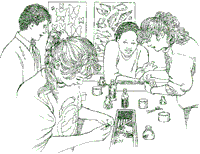 Objectives Objectives
- Students will investigate a small portion of a natural area and identify those plants and animals which coexist there.
- Students will be able to predict the kinds of plants and animal life that will be found in selected study areas. A variety of different areas near the school site may be used or a field trip may be taken to a particular environment selected for study.
Generalizations
Quadrat sampling or study of a small portion of a particular environment indicates the types of flora and fauna that may be found in a larger environment.
Skills
Observation, record keeping, measurement, comparison, predicting, and evaluating.
Activities
 Explain that a quadrat is a rectangular area used for ecological studies. Discuss particular natural areas that students could select to study and why the area should be selected. Explain that a quadrat is a rectangular area used for ecological studies. Discuss particular natural areas that students could select to study and why the area should be selected.
a. school yard
b. sloping area
c. wooded area
d. edge of woods (ecotone)
e. near stream
f. burned area
g. near lake
h. old field
i. roadside
j. stream corridor
h. ditch
- Have students measure rectangular areas of one square yard, one square foot, eight square feet. Stake out the four corners of each area and square off with a string.
- Investigate the area within the quadrat using such equipment as hand lenses, soil thermometer, soil pH test kits, weather instruments and field library. Field identification keys may also be used. Record the following information both in written and pictorial form if possible and be thorough!
a. area of the quadrat
b. temperature of soil and air
c. soil pH
d. type of soil i.e.: mud, sand, gravel
e. weather conditions
f. kinds of plants
g. number of each kind of plant
h. kinds of animals
i. number of each kind of animal
- Collect and compare data from quadrates found in different environments (forest, edge of sidewalk, stream bank, open field). Try to get the students to offer reasons for the difference found.
- Observe the quadrates at different times of the year. Do the observations vary? Can the students give reasons why?
- Give the students selected information abut a quadrat that they have not seen before. Based on their studies have them try to predict what else might be found in the selected area.
Materials
yard sticks
hand lenses
air thermometer
worksheets
stakes
soil thermometers
psychrometer
string
soil pH kits
plant and animal identification cards
Please download the PDF for complete lesson plan. |

 Objectives
Objectives

 Explain that a quadrat is a rectangular area used for ecological studies. Discuss particular natural areas that students could select to study and why the area should be selected.
Explain that a quadrat is a rectangular area used for ecological studies. Discuss particular natural areas that students could select to study and why the area should be selected.